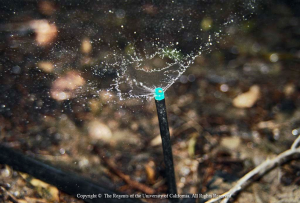Adapted from the article “Frost Protection” by Joe Connell, UC Farm Advisor, Butte County in the February 2011 Sacramento Valley Prune News
Mild, radiation frosts occur on still, clear nights, often with the development of a strong inversion. Under these conditions frost protection can be provided by running water. Advection frosts are more severe and usually result in more damage. They occur when wind present as cold air moves into a field from areas outside the orchard. Cold air accumulates in low spots or in areas where air drainage is blocked.
Soil and Groundcover Condition
Groundcover condition affects orchard minimums with any cover taller than 4 inches generally being colder. Soil heat storage is reduced because sunlight is reflected and water is evaporated. Keeping groundcovers cut short to 2 inches or less during frost season allows sunlight to reach the soil surface, and increases soil heat storage resulting in a warmer orchard through the night.
Bare, moist soil is warmest, but this is true only when the surface is moist. If pre-frost conditions are dry and windy and a dry crust forms on the surface, bare soil can be colder than a surface with a short (less than 2 inch) groundcover that tends to keep the surface moist with dew from the grasses and weeds. The ground surface must be moist for bare ground to be warmest.
Dry or recently cultivated soil has many air spaces, lower heat storage capacity, and low heat conductivity resulting in colder minimum temperatures. Moist soil stores more heat due to water content, has higher conductivity, and will have higher minimum temperatures. Irrigation should ideally wet the top foot over the entire orchard surface, soil moisture should be near field capacity, and these conditions should be achieved in advance to gain the most advantage. A light irrigation to moisten the soil before a frost will help obtain the greatest heat storage.
Frost Sensitivity
If water is used for frost protection, critical temperatures for frost damage help us know when to turn irrigation systems on or off. At first white, buds are more resistant to cold compared to full bloom stage, which is more resistant than small fruits.
Sprinklers and Micro-sprinklers
Under tree sprinklers provide protection because heat contained in water is released into the orchard system. As water cools and freezes, it releases a great deal of latent heat. This sensible heat is radiated or convected into the trees, thus providing protection. Sprinklers can be safely turned off when the wet bulb temperature upwind of the protected orchard is above the critical crop damage temperature or when all the ice melts.
In some orchards, frost protection is limited by the amount of water or available pipe. In an experiment compared protection with sprinkler lines in every middle, every other middle or every fourth middle. Air temperature in all sprinkled areas was 1-2 oF warmer than the unsprinkled control and there were no differences between spacings. Soil surface temperatures were colder the further from the sprinklers with the dry centers between the lines in every fourth middle as cold as the unsprinkled control. Line spacing directly affects soil surface temperature but air movement evens out the benefits. Without air movement, protection may fail between widely spaced lines.
In our experiments with micro-sprinklers applying 15, 25, and 40 gallons per minute per acre. Application rate had little effect on air temperature but did affect exposed temperature. Exposed temperatures (what the buds experience) were 1-2 oF warmer at the higher water rates. This indicates protection with micro-sprinklers is coming mostly from direct radiation from the warmer wet spots rather than through convection of warmer air. There was a greater separation in exposed temperatures between the low and medium/high rates on the colder nights. Under windy advective conditions convection heating is negatively affected by wind but radiation is unaffected.

Microsprinkler.
Drip irrigating in advance of a frost can help keep the orchard warmer by increasing soil heat storage particularly if the soil surface is dry. Running the system during a frost may provide slight benefits due to radiation heating from the wetted area beneath the trees. Flood irrigation for frost protection works in a similar fashion but due to larger water volumes it will provide more protection.


Leave a Reply